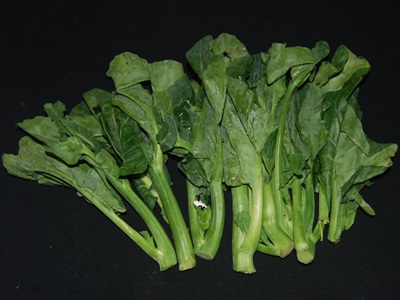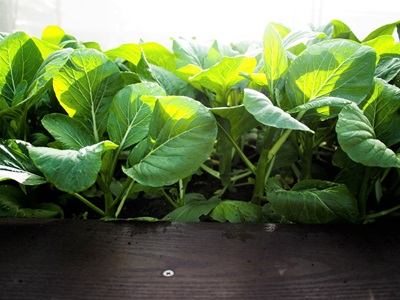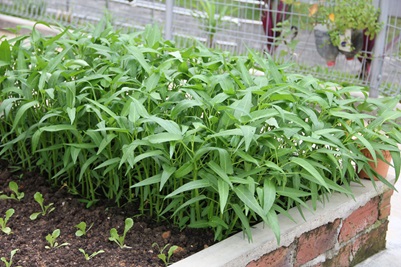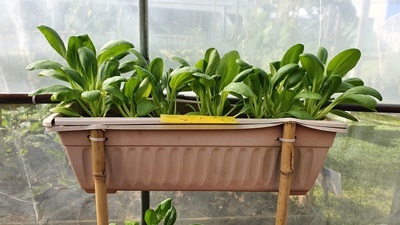Growing Five Leafy Vegetables

Published on
09 Jan 2022
Published by
National Parks Board
How well do you know your leafy vegetables?
This term generally refers to the leaves or roots of food crops, such as Kailan, Kale, Lettuce and Sweet Potato. Leafy vegetables can often be harvested in a short time period, making it ideal for impatient first-time gardeners to try to cultivate! In fact, from seed to harvest, these edibles below take only three weeks to three and a half months to grow.
Learn more about five leafy vegetables, part of the Gardening with Edibles seeds distribution:
Kailan (Brassica oleracea)

Photo credit: Jennie Tang
Kailan is grown throughout Southeast Asia. It is a herbaceous annual which means it dies completely at the end of its growing season. Kailan takes three to five days to germinate, and from between 21 to 55 days to be ready for harvest.
Belonging to the Alboglabra group, this plant grows best in well-draining soil. It requires full sun and moderate watering and can be propagated by seeds. Although Kailan and Broccoli are different varieties of the same species, when used in cooking, their flavours are very similar. However, most people find Kailan to be slightly more bitter. The leaves and stems are boiled, steamed or stir-fried.
Want to add a pop of colour to your surroundings or attract butterflies to the neighbourhood? Here are five plants suitable for roadside verges, balcony gardens and allotment plots that will brighten up any green space and attract biodiversity to your neighbourhood.
Chinese Mustard (Brassica juncea)
.jpg?h=267&w=401&la=en&hash=C8EEDC4E0496F409059C30A9EBBDA9BB3A0623BA)
Photo credit: Vicky Lim Yen Ngoh
Chinese Mustard is a herbaceous annual. It takes three to five days to germinate, and about 40 days to be ready for harvest.
This plant grows best in well-draining soil, requiring full sun and moderate watering. It can be propagated by seeds. The entire plant can be eaten, from its flower to its roots and seeds. The leaves are eaten raw in salads or cooked. The seeds are used in curries and pickles and oil extracted from the seeds is used as mustard flavouring!
Caixin (Brassica rapa)

Photo credit: Jacqueline Chua
Belonging to the Parachinensis group, Caixin is a herbaceous annual. While it takes three to five days to germinate, you will need to wait about 30 to 40 days for the plant to be ready for harvest.
Growing best in well-draining soil, Caixin requires full sun and moderate watering. It can be propagated by seeds but the seeds should be dried for at least a week before sowing. You can choose to eat its leaves raw, stir-fried, lightly boiled or steamed. The mild flavour of the crunchy stems and soft leaves make Caixin a good match for many different foods.
Kang Kong (Ipomoea aquatica)

Photo credit: Shi Biying
A member of the Morning Glory family, Kang Kong is a creeper. It is in the same genus as the Sweet Potato and takes about three days to germinate, and about 21 days to be ready for harvest.
This plant grows best in well-draining soil. It requires full sun and moderate watering and can be propagated by seeds or stem cuttings. The leaves and stems are eaten raw, blanched or stir-fried.
Xiao Bai Cai (Brassica rapa)

Photo credit: Jacqueline Chua
Also known as Bok Choy, Xiao Bai Cai is a herbaceous annual that belongs to the Chinensis group. You can find two common varieties of this plant – one with green stems and another with white stems. It takes about three days to germinate, and 40 to 45 days to be ready for harvest.
Xiao Bai Cai grows best in well-draining soil. It requires full sun and moderate watering and can be propagated by seeds or stem cuttings. Its leaves are eaten boiled, blanched, or stir-fried. The green-stemmed variety has a milder flavour, with more tender leaves and less juicy stems than the white-stemmed variety.
Gardening with Edibles
NParks will be distributing a total of 400,000 seed packets of edible plant varieties to interested members of public this year, as part of the Gardening with Edibles programme under the Edibles Horticulture Masterplan. Through the programme, NParks aims to encourage the public to garden at home or in community and allotment gardens, as well as give them the opportunity to play a key role in the ownership and stewardship for nature as we grow our City in Nature, which will bring forth benefits of health and well-being.
The seed packet will contain one type of leafy vegetable from among 10 varieties and a plant care sheet in four languages. This brings the total number of seed packets distributed under the Gardening with Edibles programme since its launch in June 2020 to some 860,000, complemented with a slew of free online resources and workshops catering to different skill levels.
The programme is also aligned with Singapore’s national strategy to strengthen our food resilience and reach the “30 by 30” goal led by the Singapore Food Agency. The Gardening with Edibles programme was established with the support of founding partners DBS Bank and Tote Board, as well as the Garden City Fund, a registered charity established by NParks. This round of seed packet distribution is made possible by the programme’s partner Singapore Post Limited, through the Garden City Fund.
Gardeners’ Day Out
Participate from the comfort of your home with online activities such as talks and demonstrations, video tutorials of activities and promotions offered. Enjoy Gardeners’ Day Out online at www.nparks.gov.sg/GDO.
You can also enjoy videos of our Gardening With Edibles Masterclass Series. They are conducted by NParks horticulturists, focusing on unique and challenging edibles across different plant families.
Learning More
If you are a gardening newbie, visit NParksSG, our refreshed YouTube Channel that serves as a one-stop repository for close to 300 video resources. It covers topics ranging from types of soil needed for your garden and how to plant, harvest and even cook your edibles.
For more information about the flora and fauna found in Singapore, please visit NParks Flora and Fauna Web.
If you like what you read, follow us on Facebook, Instagram and Telegram to get the latest updates.
Text compiled by Felix Siew
Source: National Parks Board. Reproduced with permission.
ALL views, content, information and/or materials expressed / presented by any third party apart from Council For Third Age, belong strictly to such third party. Any such third party views, content, information and/or materials provided herein are for convenience and/or general information purposes only. Council For Third Age shall not be responsible nor liable for any injury, loss or damage whatsoever arising directly or indirectly howsoever in connection with or as a result of any person accessing or acting on any such views, content, information and/or materials. Such third party views, content, information and/or materials do not imply and shall not be construed as a representation, warranty, endorsement and/or verification by Council For Third Age in respect of such views, content, information and/or materials.







